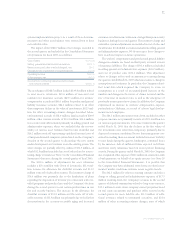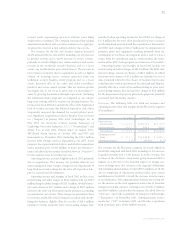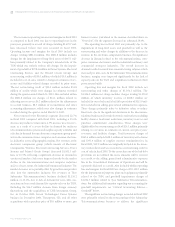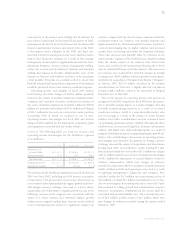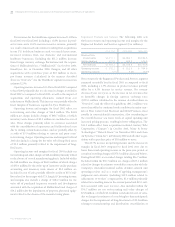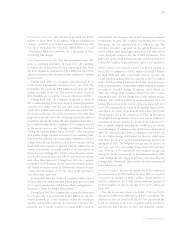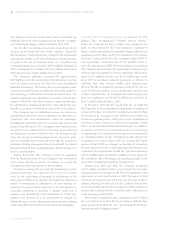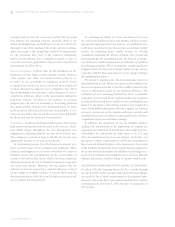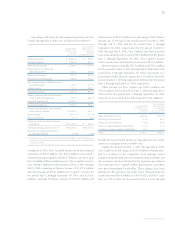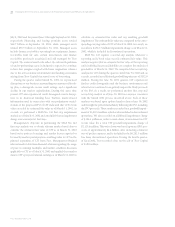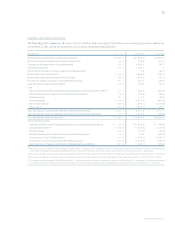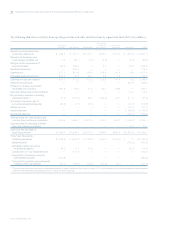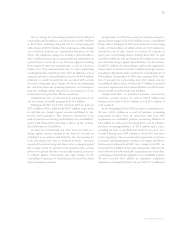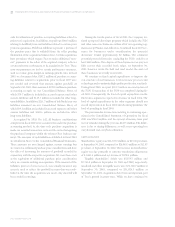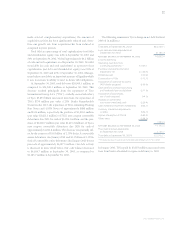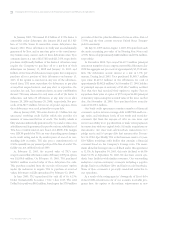ADT 2003 Annual Report Download - page 43
Download and view the complete annual report
Please find page 43 of the 2003 ADT annual report below. You can navigate through the pages in the report by either clicking on the pages listed below, or by using the keyword search tool below to find specific information within the annual report.
41
CRITICAL ACCOUNTING POLICIES
The preparation of consolidated financial statements in con-
formity with GAAP requires management to use judgment in
making estimates and assumptions that affect the reported
amounts of assets and liabilities, disclosure of contingent assets
and liabilities and the reported amounts of revenues and
expenses. The following accounting policies are based on,
among other things, judgments and assumptions made by
management that include inherent risks and uncertainties.
Management’s estimates are based on the relevant information
available at the end of each period.
Long-Lived Assets Management periodically evaluates the net
realizable value of long-lived assets, including property, plant
and equipment and amortizable intangible assets, relying on a
number of factors including operating results, business plans,
economic projections and anticipated future cash flows. We
carry long-lived assets at the lower of cost or fair value. Fair
values are based on assumptions concerning the amount and
timing of estimated future cash flows and assumed discount
rates, reflecting varying degrees of perceived risk. Since judgment
is involved in determining the fair value of long-lived assets,
there is risk that the carrying value of our long-lived assets may
be overstated or understated.
The Company generally divides its electronic security assets
into various asset pools: internally generated residential systems,
internally generated commercial systems and accounts acquired
through the ADT dealer program (discussed below under
“Amortization Method for Customer Contracts”).
With respect to the Company’s depreciation policy for secu-
rity monitoring systems installed in residential and commercial
customer premises, the costs of these systems are combined in
separate pools for internally generated residential and com-
mercial account customers, and generally depreciated over ten
years. The Company concluded that for residential and com-
mercial account pools the straight-line method of amortization
over a ten-year period continues to be appropriate given the
observed actual attrition data for these pools.
The determination of the depreciable lives of subscriber
systems included in property, plant and equipment, and the
amortizable lives of customer contracts and related customer
relationships included in intangible assets, are primarily based
on historical attrition rates, third-party lifing studies and the
useful life of the underlying tangible asset. The realizable value
and remaining useful lives of these assets could be impacted
by changes in customer attrition rates. If the attrition rates
were to rise, the Company may be required to further accelerate
the amortization.
Goodwill Effective October 1, 2001, the beginning of Tyco’s
fiscal year 2002, we adopted SFAS No. 142, “Goodwill and
Other Intangible Assets,” under which goodwill is no longer
amortized but instead management assesses goodwill for
impairment at least as often as annually and as triggering
events occur. In making this assessment, management relies on
a number of factors including operating results, business plans,
economic projections, anticipated future cash flows, and trans-
actions and marketplace data. There are inherent uncertainties
related to these factors and management’s judgment in applying
them to the analysis of goodwill impairment. Since manage-
ment’s judgment is involved in performing goodwill valuation
analyses, there is risk that the carrying value of our goodwill
may be overstated or understated.
We elected to make July 1 the annual assessment date for all
reporting units. Goodwill valuations have historically been
calculated using an income approach based on the present
value of future cash flows of each reporting unit. This approach
includes many assumptions related to future growth rates,
discount factors, future tax rates, etc. Changes in economic and
operating conditions impacting these assumptions could result
in a goodwill impairment in future periods.
Disruptions to our business such as end market conditions
and protracted economic weakness, unexpected significant
declines in operating results of reporting units, the divestiture
of a significant component of a reporting unit, downgrades in
our credit ratings, and market capitalization declines may result
in our having to perform a SFAS No. 142 first step valuation
analysis for all of our reporting units prior to the required
annual assessment. These types of events and the resulting
analysis could result in additional charges for goodwill and
other asset impairments in the future.
Amortization Method for Customer Contracts The Company
purchases residential security monitoring contracts from an
external network of independent dealers who operate under
the ADT dealer program. The purchase price of these customer
contracts is recorded as an intangible asset (i.e., contracts and
related customer relationships).
As discussed above in “Long-Lived Assets,” the Company
generally divides its electronic security assets into various asset
pools: internally generated residential systems, internally gen-
erated commercial systems and accounts acquired through the
ADT dealer program. Intangible assets arising from the ADT
dealer program described above are amortized in pools deter-
mined by the month of contract acquisition on an accelerated
basis over the period and pattern of economic benefit which is
expected to be obtained from the customer relationship. The
TYCO INTERNATIONAL LTD.


